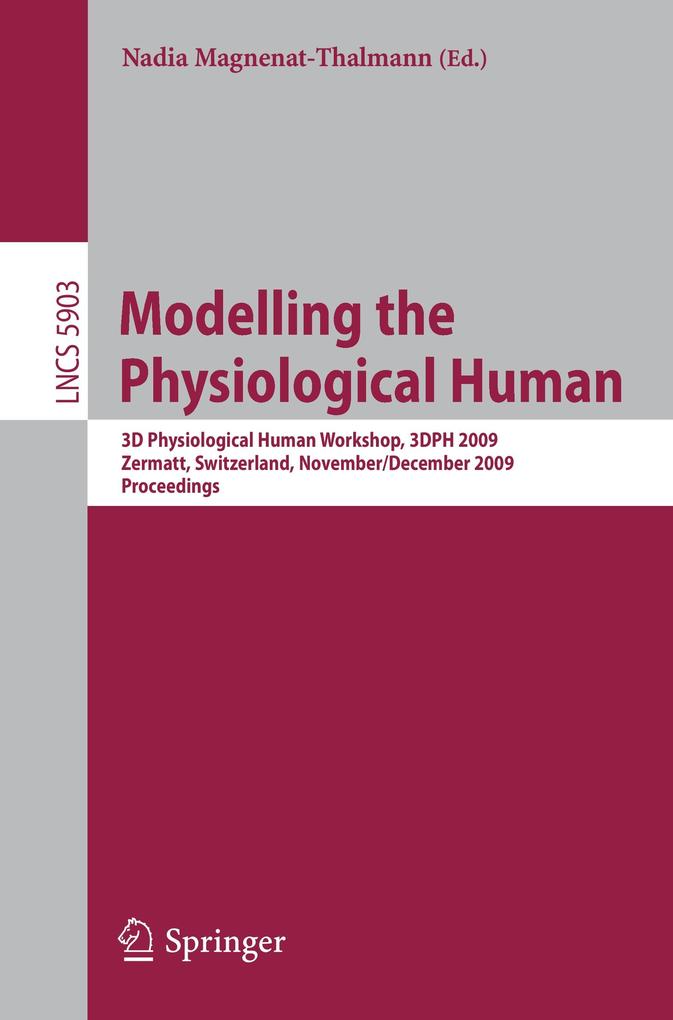
Zustellung: Sa, 18.01. - Di, 21.01.
Versand in 2 Tagen
VersandkostenfreiBestellen & in Filiale abholen:
Thisbook presentsrecentadvancesinthedomainofthe3Dphysiologicalhuman that werepresentedlastDecember at the Workshopon 3D PhysiologicalHuman 2009 that was held in Zermatt, Switzerland. This workshop was funded by the Third Cycle in Computer Science of Western Switzerland named CUSO, the European project Focus K3D (ICT-2007-214993), the European Marie Curie project 3D Anatomical Human (MRTN-CT-2006-035763) and the European Network of Excellence InterMedia (NoE-IST-2006-038419). 3D physiological human research is a very active ? eld supported by several scienti? c projects. Many of them are funded by the European Union, such as the 3D Anatomical Human project and those present in the seventh framework programme Virtual Physiological Human (FP7-ICT-2007-2). One of the main objectivesof the researchon 3D physiologicalhuman is to create patient-speci? c computer models for personalized healthcare. These models are used to simulate and hence better understand the human physiology and pathology. There is also a synergy in this research in the way medical information is distributed: to have any model available anytime, anywhere on any mobile equipment. A collection of scienti? c articles was proposed to highlight the necessity to exchange and disseminate novel ideas and techniques from a wide range of d- ciplines (computer graphics, biomechanics, knowledge representation, human machine interface, mobile computing, etc.) associated with medical imaging, medical simulation, computer-assisted surgery and 3D semantics. The emphasis wason technicalnoveltyalongwith currentandfuture applications for modeling and simulating the anatomical structures and functions of the human body.
Inhaltsverzeichnis
Segmentation. - Vessels-Cut: A Graph Based Approach to Patient-Specific Carotid Arteries Modeling. - Interactive Segmentation of Volumetric Medical Images for Collaborative Telemedicine. - Simultaneous Segmentation and Correspondence Establishment for Statistical Shape Models. - The Persistent Morse Complex Segmentation of a 3-Manifold. - Anatomical and Physiological Modeling. - Modelling Rod-Like Flexible Biological Tissues for Medical Training. - Using Musculoskeletal Modeling for Estimating the Most Important Muscular Output Force. - Computer Assisted Estimation of Anthropometric Parameters from Whole Body Scanner Data. - Simulation Models. - A Physiological Torso Model for Realistic Breathing Simulation. - Evaluating the Impact of Shape on Finite Element Simulations in a Medical Context. - MotionLab: A Matlab Toolbox for Extracting and Processing Experimental Motion Capture Data for Neuromuscular Simulations. - Motion Analysis. - Predicting Missing Markers in Real-Time Optical Motion Capture. - Motion Analysis of the Arm Based on Functional Anatomy. - WAPA: A Wearable Framework for Aerobatic Pilot Aid. - Discriminative Human Full-Body Pose Estimation from Wearable Inertial Sensor Data. - Medical Visualization and Interaction. - A 3D Human Brain Atlas. - Context Preserving Focal Probes for Exploration of Volumetric Medical Datasets. - Use of High Dynamic Range Images for Improved Medical Simulations. - Medical Ontology. - My Corporis Fabrica: A Unified Ontological, Geometrical and Mechanical View of Human Anatomy. - Formal Representation of Tissue Geometric Features by DOGMA Ontology.
Produktdetails
Erscheinungsdatum
17. November 2009
Sprache
englisch
Auflage
2009
Seitenanzahl
240
Reihe
Lecture Notes in Computer Science
Herausgegeben von
Nadia Magnenat-Thalmann
Verlag/Hersteller
Produktart
kartoniert
Abbildungen
X, 229 p.
Gewicht
371 g
Größe (L/B/H)
235/155/14 mm
ISBN
9783642104688
Entdecken Sie mehr
Bewertungen
0 Bewertungen
Es wurden noch keine Bewertungen abgegeben. Schreiben Sie die erste Bewertung zu "Modelling the Physiological Human" und helfen Sie damit anderen bei der Kaufentscheidung.










